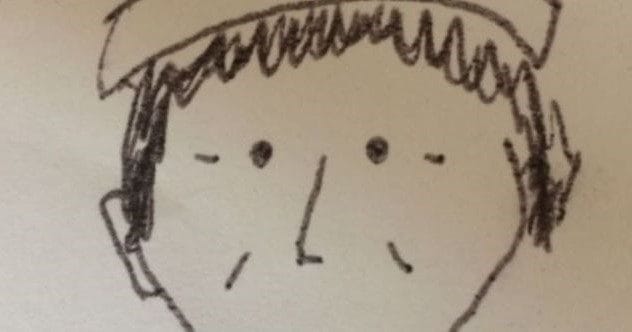Police sketches are fascinating tools used in crime-solving. They’re drawings of suspects, created from a witness’s memory or sometimes from a victim’s remains. But let’s be honest, these sketches aren’t always spot-on. Witness memory can be fuzzy, and artistic skill varies.
Because of this, forensic artists sometimes exaggerate a person’s most noticeable features. This helps make the sketch stand out and hopefully jogs someone’s memory. The outcome? Sketches that can look hilariously cartoonish or even like something from a nightmare. Get ready to explore 10 such wild police sketches and the equally strange stories connected to them. Be warned: while some will make you laugh, others are genuinely creepy!
10. The Girl in the Suitcase
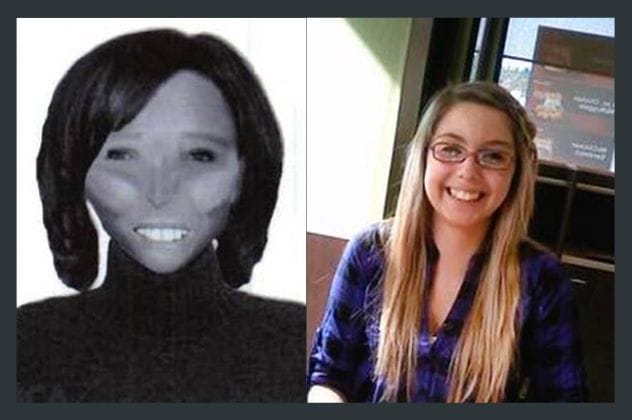
In 2014, a shocking discovery was made: two suitcases, each holding the body of a woman. Laura Simonson was identified quickly, but the second woman was a mystery. Police released a sketch, but her body was so decomposed that artists chose to highlight certain features dramatically. This is a common tactic to help people differentiate the face from countless others and to trigger memories by emphasizing key traits. The result was a sketch that looked like a strange alien-chipmunk creature.
Amazingly, a family saw this unusual sketch and found the prominent buck teeth, small lower teeth, high cheekbones, and small eyes strikingly similar to a relative they hadn’t heard from. This lead allowed authorities to use dental records and confirm the identity of Jenny Gamez. Tragically, Jenny was killed by a former police officer whom she met online, on their very first date. Thanks to the artist’s decision to exaggerate features, she was identified, reminding us that even a seemingly odd sketch can serve a vital purpose.
9. Deandre Charles
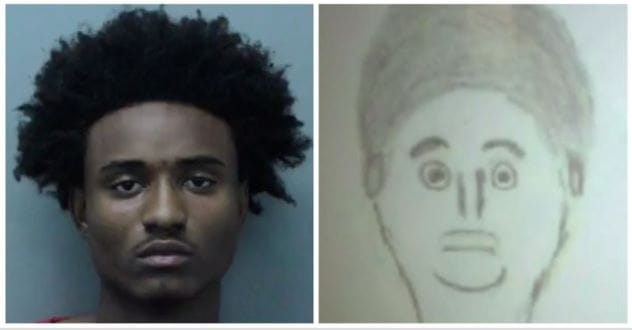
Also in 2014, Rabbi John Raskins was tragically shot and killed during a visit to Miami. A witness to the crime provided their own hand-drawn sketch of the suspect. It looked more like a character from a cartoon like Bob’s Burgers than a typical police sketch. Yet, police used this drawing to quickly identify a suspect: 14-year-old Deandre Charles.
When police released a mugshot of Deandre alongside the sketch, many people made fun of the drawing. However, it did bear a slight resemblance, like one of those apps that turns your photo into a cartoon character. It seemed like another crime solved by a sketch. But was it? The issue here was that law enforcement didn’t just use the sketch as a starting point; they treated it almost like solid proof. Deandre Charles was investigated and faced trial for three years before DNA evidence finally cleared him.
Imagine being accused of murder because of a quirky sketch that vaguely looked like you. Deandre was understandably upset and later sued the authorities, claiming prosecutors had DNA evidence that could have cleared him much sooner but still pursued the case. He has since channeled his experience into a music career as Papito El Franklins, and he’s quite good!
8. Horrible Drawing, Great Results
Jocelyn Park was at her favorite stall in Lancaster, PA’s Central Market when she saw an unfamiliar man behind the counter holding cash. After the man got away, Jocelyn contacted the police. But first, she decided to quickly sketch the man while his image was fresh in her mind. As a graphic designer with two art degrees, she thought she could do a decent job. However, the sketch she produced was… very simple. It quickly went viral, with many people mocking it online and news anchors struggling not to laugh when showing it.
Jocelyn admitted the criticism stung, but she remained confident her drawing would lead to an arrest, no matter how amateur it looked. And she was right! An officer saw the sketch and thought it resembled someone they knew. The officer then prepared a photo lineup, and Jocelyn identified the same suspect. About a week after Park’s drawing was released, Hung Phuoc Nguyen was arrested. After the arrest, public opinion shifted, with many admitting there was a strong resemblance between Jocelyn’s sketch and the culprit. Jocelyn felt vindicated. This story shows that even a simple sketch, if treated as a tool, can be incredibly effective, unlike the previous case where a sketch was mishandled.
7. The Crimes of Lettuce Head
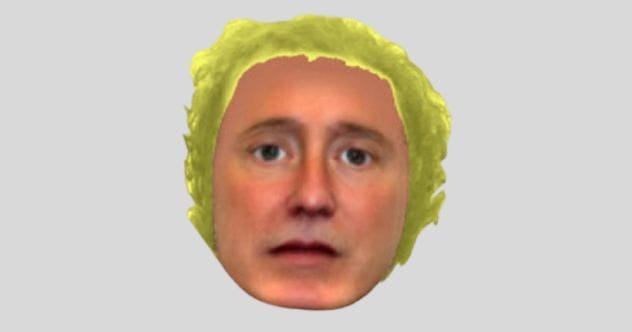
To truly get this next absurd image, we need to talk about E-FITs. E-FIT, short for electronic facial identification technique, uses computers to create a facial composite from a witness’s description. People often struggle to describe individual facial features, but they usually recognize a face when they see one. E-FITs try to leverage this. Witnesses describe aspects of a person, the computer pieces them together, and then shows slight variations until the witness (hopefully) picks the most accurate one.
As you might guess, this can produce some truly bizarre results, but perhaps none more so than the infamous “lettuce head.” This E-FIT was created based on the description from an elderly woman who had £60 stolen from her purse. The burglar was described as having “wavy blonde/greying hair,” but the E-FIT showed something else entirely. A Hampshire Constabulary spokesperson said they released this unusual image because the facial features were clear, and it would have been wrong to withhold it. They added, “We are, though, currently experiencing technical problems with the quality of the hair and are waiting for an upgrade to the system.” You don’t say! Surprisingly, lettuce head was never caught. As one person commented, “Maybe he returned to his roots.”
6. Big Mouth
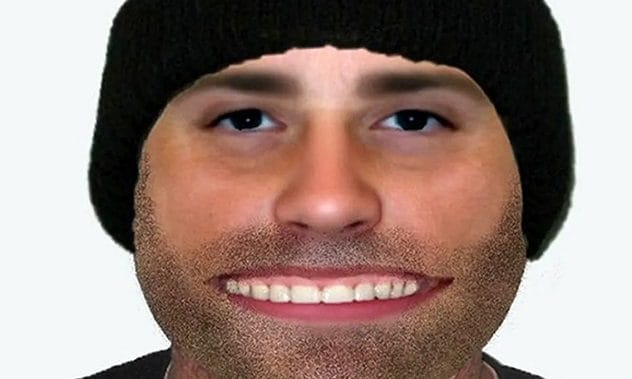
You might be thinking this is another E-FIT glitch, but it’s not! This E-FIT was generated exactly as the victim described the suspect. In fact, the Warwickshire Police knew how odd the E-FIT looked when they shared it on Twitter. They even stated that the victim had approved the picture’s quality. Despite the widespread ridicule and memes (the Twitter thread is worth checking out for a laugh), the Warwickshire Police followed up by thanking everyone for the online exposure.
This case involved a distraction burglary. The suspect pretended to be a worker from a housing company, talked his way into the victim’s home, and stole a small amount of cash. One can certainly see how the victim might have been distracted, and it probably wasn’t just by his charm. Unfortunately, that seems to be where the story of old smiley ends. It’s a shame for the victim who didn’t get justice, but maybe it’s good for the rest of us, so we don’t have to imagine a man with a giant mouth trying to enter our homes. He’s like an evil tooth fairy… or perhaps a toothy fairy? I’ll let myself out.
5. John List Clay Bust
This artistic recreation gets extra points for being different. While many artists on this list exaggerated features to an extreme, this artist aimed for the opposite: a hyper-realistic, three-dimensional representation of the suspect. In May 1989, forensic artist Frank Bender appeared on the TV show America’s Most Wanted with a life-like clay bust. This bust was an age-progressed model of a man named John List.
List’s story was tragically familiar: a seemingly nice guy with a perfect family, a good job, and a perfect life. The problem was, List lost his job. He pretended to go to work for weeks as debt mounted. Deciding he wanted a fresh start, List horrifically shot and killed his wife, children, and mother. He then went on the run and managed to evade capture for 18 years. That is, until the episode of America’s Most Wanted aired. Less than two weeks later, the FBI arrested an accountant in Virginia named Robert Clark. Someone who saw the show thought Robert Clark looked strikingly similar to the clay bust of John List and called in a tip. Fingerprint evidence confirmed Robert Clark was indeed John List, and he was convicted in 1990.
4. Cheryl Bowman
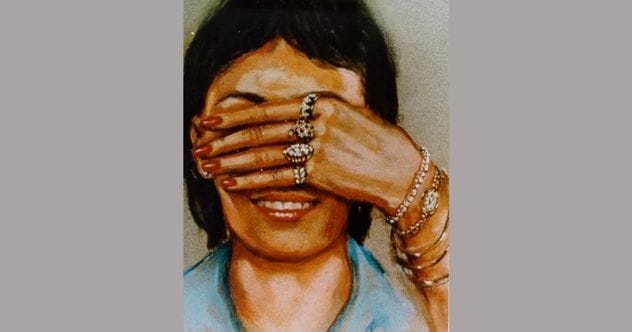
One morning in Houston in 1989, people searching for aluminum cans discovered the decomposing body of a woman. She wore a lot of jewelry, had very nice teeth, and neatly polished red nails. That was about all that was initially known. Many details about this case remain unclear, and it’s hard to tell fact from speculation. However, what has made this Jane Doe case memorable is the unusual sketch of the woman.
The sketch shows the woman smiling, with her hand covering the upper half of her face. This pose makes sense as it highlights her defining characteristics: her jewelry, painted nails, and teeth. A narrative also developed suggesting she was covering her face because it was too decomposed or beaten to be recognizable. While this isn’t officially confirmed, it adds a layer of drama to the case. The woman was later identified as Cheryl Bowman, though details on how she was identified are scarce. This sketch is certainly captivating. The hand over the face and the Cheshire-cat-like smile create a creepy “I know something you don’t” vibe, like a grim game of peek-a-boo. Kudos to the artist, as the sketch not only helped identify the victim but also continues to intrigue internet sleuths who hope to find out what happened to Cheryl Bowman.
3. Glenn Edwin Rundles
How about another hilariously basic sketch that makes the suspect look like a cartoon character? This sketch of Rundles was released after a knifepoint robbery. It’s important to remember these sketches are usually approved by the victim(s) before release. In this case, two witnesses developed the sketch. That means two people looked at this drawing and said, “Yep, that’s him.”
An officer saw the sketch and thought it looked a lot like Rundles, who was then identified by the victims. Once again, the seemingly goofy sketch proved effective, giving the artist the last laugh. In fact, Rundles himself saw the sketch in the newspaper and thought it resembled him so much that he tried to alter a tattoo on his neck to hide his identity. Perhaps he should have tried a fake mustache and glasses next time.
2. Selene Delgado Lopez
As we’ve seen, police sketches can deeply embed themselves in one’s mind. When you combine this with the internet’s viral power, a sketch can become imprinted on an entire population. These sketches can then evolve and take on a life of their own, as happened with Selene Delgado Lopez. In the 1990s and 2000s, Mexican Channel 5 (Canal 5) aired short segments called “Servicio de la comunidad” between programs. These showed photos of missing persons while a narrator read their description and last known whereabouts. Selene Delgado Lopez was a frequent entry.
For years, her grainy photo was featured, but there were never any updates to her picture or information. Something about the photo and her constant appearances struck a chord, and Selene became an urban legend with many theories about her. Due to the lack of information, a popular idea arose that Selene wasn’t real but an AI-generated image. A YouTube video even compared Selene’s facial features to other photos and sketches, noting a strong resemblance to a police sketch of Derrick Todd Lee, the Baton Rouge serial killer. Lee terrorized Baton Rouge in the ‘90s and early ‘00s and was caught partly thanks to this sketch. Even after his capture, it’s no surprise this sketch has lived on online. The stark, expressionless face and wild, wide eyes truly convey the feeling of a cold, violent murderer. While the comparison between Selene and the sketch is eerie, it likely feels like a coincidence. The full story of Selene Delgado Lopez is too extensive for this list, involving a Facebook hoax, creepy videos from Canal 5’s official Twitter, and even video game mods—all stemming from a creepy missing person alert and an even creepier police sketch that went viral.
1. The Ina Jane Doe
In 1993, two girls in Illinois found a severed head tangled in bushes at Wayne Fitzgerrell State Park near Ina. Authorities determined the head belonged to someone who had died within the previous two weeks but couldn’t match it to any local missing persons. This led to what I believe is the most terrifying police sketch ever created. So, what’s the story behind this drawing?
As mentioned, artists often amplify certain characteristics to extreme proportions to help people recognize them. In this case, the Ina Jane Doe had Wryneck Syndrome, a condition that twists the neck, causing the head to tilt at an unusual angle. This explains the awkward pose. The artist also chose to exaggerate her facial asymmetry, giving her a somewhat ghoulish look. Unfortunately, the artist’s efforts didn’t lead to any breaks in the case, and it went cold. It took 29 years, but the case was re-examined in 2022, and the Ina Jane Doe was identified as Susan Hope Lund through DNA analysis. It’s unclear why this specific case was chosen for re-analysis, but the sketch’s notoriety might have drawn investigators’ interest. It’s clear Susan bore little resemblance to the famous sketch: her wryneck wasn’t nearly as pronounced, nor was her facial asymmetry. While identifying the Ina Jane Doe brought some closure to her family (her children had been led to believe she abandoned them), the mystery of her murder remains. To this day, that police sketch continues to circulate online, imprinting itself on those who see it. Now, it can also share the story of Susan Hope Lund and perhaps help solve her murder.
A Sketchy Conclusion
Police sketches are truly a mixed bag. Sometimes they’re surprisingly accurate, leading directly to a suspect. Other times, they’re so bizarre they become internet famous for all the wrong (or right?) reasons. Yet, as these stories show, even the wildest, most cartoonish, or downright terrifying sketches can play a crucial role in bringing criminals to justice or giving a name back to an unknown victim. They highlight the complexities of memory, the creativity of forensic artists, and the enduring power of a single image to captivate and, sometimes, to solve mysteries.
What do you think is the wildest police sketch you’ve ever seen? Share your thoughts and any strange sketch stories you know in the comments below!


